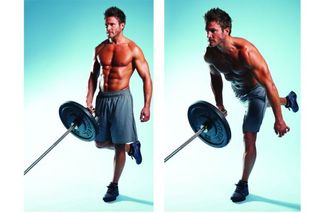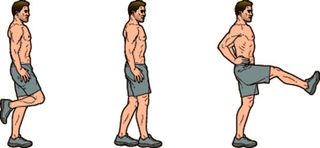Must-do move: Single-leg landmine deadlift
Work your weak spots, build your legs and improve your running with the single-leg landmine deadlift

The single-leg Romanian deadlift is an excellent move to do – as long as your balance is up to scratch. If you’re less gazelle and more Bambi-on-a-frozen-lake, the weight you can handle will be limited by your wobbling support leg. The solution? Keep one end of the bar on the floor, either tucked into a corner, a weight plate or a purpose-built bit of kit called a landmine. You’ll be able to load up the bar to work your hamstrings and improve your balance.
How to do it

Sets 3 Reps 8 each side Rest 30sec
With one end of a barbell secured on the floor, grip the other end and stand on one leg, keeping a very slight bend in your other leg. Lean forward as far as possible, allowing your planted leg to bend a little, then stand back up, keeping your back straight throughout. Add this one to the end of leg day as a potent finisher.
More of the moves that you should be doing.
Sixth sense
Improve your proprioception and unlock hidden reserves of agility and strength
Proprioception is your body’s ability to transmit a sense of position, analyse that information and react – consciously or unconsciously – with the proper movement. It’s part balance, part co-ordination, part agility, and recent studies suggest that it can be improved. Here’s how.

1. Tandem stance
Get the Coach Newsletter
Sign up for workout ideas, training advice, reviews of the latest gear and more.
The first move to master. Stand with one foot in front of the other, heel to toe. Hold for 30 seconds, then shut your eyes for another 30. Repeat on the other side.
2. Stork
Or, as you know it, standing on one leg. Once you can hold it with your eyes closed, mimic running movements with your arms to further test your balance.
3.Swing
Once you’re used to single-leg balancing, add single-leg swings to your warm-up without support. Start with a straight leg, then move to using a bent knee – and speed up.
Coach is a health and fitness title. This byline is used for posting sponsored content, book extracts and the like. It is also used as a placeholder for articles published a long time ago when the original author is unclear. You can find out more about this publication and find the contact details of the editorial team on the About Us page.

